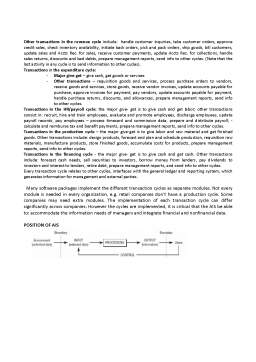Extras din curs
UNIT 1 – INTRODUCTION INTO THE UNIVERSE OF ACCOUNTING
1. THE CONCEPT OF ACCOUNTING
2. ACCOUNTING – LANGUAGE FOR COMMUNICATING IN BUSINESS
2) THE CONCEPT OF ACCOUNTING
The universe of accounting: past, present and future
The concept of accounting
• THE PERSPECTIVES OF ACCOUNTING
Today accounting is defined from two perspectives:
a. 1st perspective of accounting
The actual economic theory defines accounting as a: “domain and an instrument of the economic reality knowledge, which refers to the patrimonial separated economic resources. Accounting is considered to be, in the same time, a technique, a science and an economic language.”
b. 2nd perspective of accounting
The normalizing perspective, in the context of which the accounting is defined through its purpose (finality), respectively through “its product”, the financial statements of the company.
3) ACCOUNTING – LANGUAGE FOR COMMUNICATING IN BUSINESS
General aspects:
• The main users of the financial- accounting information
• The qualitative characteristics of the financial- accounting information
• The main limits of the financial- accounting information
• Accounting functions
The accounting language is characterized by 3 dimensions: the syntactic aspect, the semantic aspect, the pragmatic aspect.
The accounting syntax consists of the total rules and procedures that must be abided by for registering, calculating and analyzing the economic operations from an enterprise. The accounting syntax is based upon a system of symbols which form a specialized accounting vocabulary, such as: the account, the balance sheet, the debit, the credit, the assets, the liabilities, the incomes, the expenses, the results etc.
The semantic of the accounting language regards the significance of the signs transmitted by the accounting and refers to the correspondence between the described object (the enterprise’s wealth) and the accounting system or model.
The pragmatic aspect or the practice of the accounting language refers to the dialogue accomplished through the accounting information between different users of the accounting’s “products”.
The actual concerns regarding the regulation and the standardization of the accounting language lead to a regulated or standardized language worldwide, which accomplishes the description of the economic reality through symbols, numbers and words.
The existence of this kind of a language allows a greater transparency of the companies’ activities and help ease the decisional and control process.
Like all the regulated languages, the accounting language is: precise, concise and complete.
The growth of accounting’s social role determined some authors to claim that accounting is a social game, with its actors and producers (directors), with referees represented by the regulating and settling instances. Among the actors that take part in the social game that is accounting, we mention:
• The enterprises and their management
• The accountants or the producers of the accounting information
• The users of the accounting information
Between the producers and the users of the accounting information there is a lack of trust, which is the reason that determines the auditors and the certified accountants, in other words the controllers of the accounting information to intervene. They have the role to verify and certify the accounting information.
In the social game of accounting, the users of the accounting information give dynamic to the dispute between the actors and manage to impose the rules of this game.
The main users of the financial- accounting information:
IASB – Entity –Present and potential investors
- Suppliers
- Customers
- Employees
- Financial creditors
- Government
- Public
Economic Reality – Managers
- Juridical institutions
- Financial analysts
- Competitors
THE MANAGERS AND THE NEED FOR INFORMATION
The accounting is the main source of information at the level of an enterprise. The decisions taken in the leadership process are based on the accounting information which is supplied by the managerial accounting and also by the financial accounting.
THE INVESTORS
The main partners of the enterprises on the financial market are the investors. For the investors the accounting information has the role of helping them decide the moment when they must buy, conserve (keep) or sell parts of the capital.
Preview document
Conținut arhivă zip
- Unit 1 intro in the univ of accounting.doc
- Unit 2 the object of accounting conceptions reg.the object and limits of the conceptions.doc
- Unit 3 the obj of accounting, def &charact fin stat., liab&equit.doc
- Unit 4 acc.for managers AIS.doc
- Unit 5 international accounting harmonization.doc
- Unit 6 IAS conceptual framework.doc
- Unit 7 - Corporate governance social resp and ethics.doc




















































